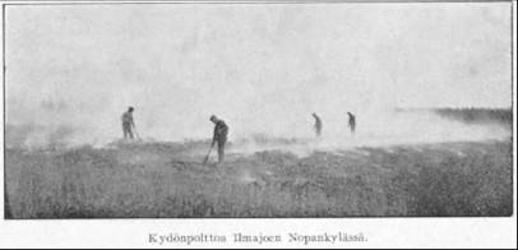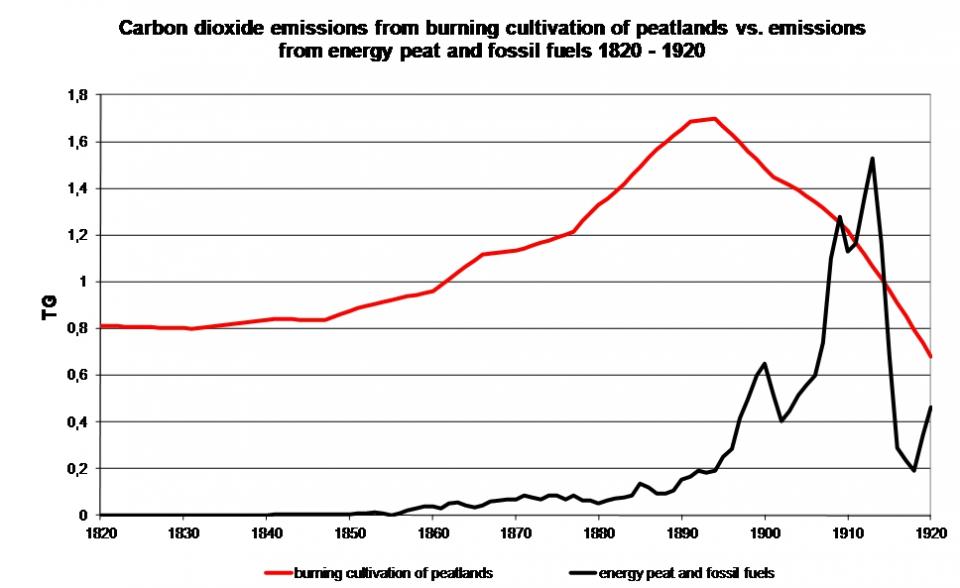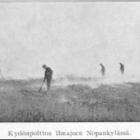The focus of historical research about fire-clearance husbandry has primarily been on the burning of forests, while swamps and other peatlands have been neglected. The methods used for burning peatland can be divided into eastern and western types. The eastern method was an adaptation of slash-and-burn cultivation and was employed to cultivate wooded peatland. The western method was more suitable for treeless peatlands and began with the ditching of the assigned peatland in order to drain the water. After the peatland had been dry for some years, it was hoed or harrowed, but not before any trees were felled and their roots dug up. Then, the twigs and peat were burned as soon as the surface had dried. Finally, rye or oats were usually sown in the ash. This process was repeated for each new yield until the bottom of the peatland was reached or the peatland was left to grow grass.

Burning a Bog in Nopankylä, Ilmajoki, South-Ostrobothnia.
Burning a Bog in Nopankylä, Ilmajoki, South-Ostrobothnia.
Samuli Paulaharju, Kotiseutu 3/1911, p. 114.
Source: Kansalliskirjasto, Historiallinen sanomalehtikirjasto
 This work is licensed under a Creative Commons Public Domain Mark 1.0 License.
This work is licensed under a Creative Commons Public Domain Mark 1.0 License.
Peatland burning is mentioned in court protocols around 1640, but it might have been practiced in Finland as early as the fourteenth century. It was most common in the peat-rich region of Ostrobothnia on the western coast of Finland, where it compensated for the diminution of forest resources caused by slash-and-burn cultivation and tar burning. In some districts of Ostrobothnia during the 1820s and 1830s, over half of the yield of some grains came from peatland cultivation. As the area of peatland burned increased in the nineteenth century, an increasing amount of attention was paid to associated bad practices, such as burning peatlands to the bottom. Gradually, burning was replaced with the use of sand, clay, and fertilizers, and it faded away altogether in the beginning of the twentieth century. If measuring by energy value, the amount of biomass burned on peatlands surpassed the amount burned via slash-and-burn cultivation after the mid-nineteenth century. When compared with other sources of carbon dioxide, such as burning peat and fossil fuels for energy, burning peatlands was by far the greatest source of carbon dioxide emissions in Finland during the entire nineteenth century through the beginning of the twentieth century. This might also be the case for other peat-rich countries.
While old swidden areas have been reforested, the marks from burning peatlands are still clearly visible in the Finnish landscape. As a memorial to this practice, the country has large field plains, especially in southern Ostrobothnia, which are nowadays officially classified as valuable landscapes.
How to cite
Kunnas, Jan. “Burning Cultivation of Peatlands in Finland.” Environment & Society Portal, Arcadia (2012), no. 18. Rachel Carson Center for Environment and Society. https://doi.org/10.5282/rcc/3931.
 2012 Jan Kunnas
2012 Jan Kunnas
This refers only to the text and does not include any image rights.
Please click on the images to view their individual rights status.
ISSN 2199-3408
Environment & Society Portal, Arcadia
- Kunnas, Jan. “A Dense and Sickly Mist from Thousands of Bog Fires.” Environment and History, 11, no. 4 (2005): 431-46. (Jstor Link)









